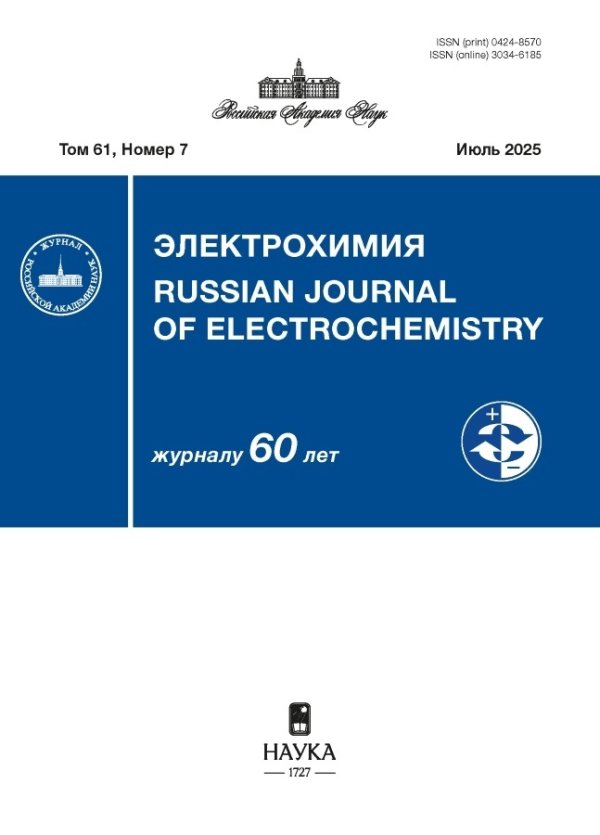Electric Transport Properties of Solid Solution and Composite Samples in the Ba2In2O5–Ba2InNbO6 System with Responce Atmospheric Humidity
- Authors: Matveev E..1, Kochetova N..1, Alyabisheva I..1, Animitsa I..1
-
Affiliations:
- Ural Federal University named after the first President of Russia B. N. Yeltsin
- Issue: Vol 61, No 6 (2025)
- Pages: 299-310
- Section: Articles
- URL: https://rjsvd.com/0424-8570/article/view/692240
- DOI: https://doi.org/10.7868/S3034618525060034
- ID: 692240
Cite item
Abstract
Thermal and electrical properties of solid solution and composite samples in the quasi-binary system Ba2In2O5–Ba2InNbO6 were investigated. It was proven that in a humid atmosphere at temperatures below 600°C the samples reversibly interact with water vapor to form proton defects. The hydration process is accompanied by a significant increase in the total electrical conductivity due to the appearance of a contribution from proton transfer. Below 500°C in humid air the samples are predominantly proton conductors. The composite effect of proton electrical conductivity was established.
About the authors
E. S Matveev
Ural Federal University named after the first President of Russia B. N. Yeltsin
Email: Egor.Matveev@urfu.ru
Ekaterinburg, Russia
N. A Kochetova
Ural Federal University named after the first President of Russia B. N. YeltsinEkaterinburg, Russia
I. V Alyabisheva
Ural Federal University named after the first President of Russia B. N. YeltsinEkaterinburg, Russia
I. E Animitsa
Ural Federal University named after the first President of Russia B. N. YeltsinEkaterinburg, Russia
References
- Singh, M., Zappa, D., and Comini, E., Solid oxide fuel cell: Decade of progress, future perspectives and challenges, Int. J. Hydrogen Energy, 2021, vol. 46, no. 54, p. 27643. doi: 10.1016/j.ijhydene.2021.06.020
- Laguna-Bercero, M.A., Recent advances in high temperature electrolysis using solid oxide fuel cells: A review, J. Power Sources, 2012, vol. 203, p. 4. doi: 10.1016/j.jpowsour.2011.12.019
- Hossain, S., Abdalla, A.M., Jamain, S.N.B., Zaini, J.H., and Azad, A.K., A review on proton conducting electrolytes for clean energy and intermediate temperature-solid oxide fuel cells, Renew. Sustain. Energy Rev., 2017, vol. 79, p. 750. doi: 10.1016/j.rser.2017.05.147
- Kasyanova, A.V., Rudenko, A.O., Lyagaeva, Yu.G., and Medvedev, D.A., Lanthanum-containing proton-conducting electrolytes with perovskite structures, Membr. Membr. Technol., 2021, vol. 3, no. 2, p. 73. doi: 10.1134/S2517751621020050
- Shen, M., Ai, F., Ma, H., Xu, H., and Zhang, Y., Progress and prospects of reversible solid oxide fuel cell materials, iScience, 2021, vol. 24, no. 12, p. 103464. doi: 10.1016/j.isci.2021.103464
- Filippov, S.P. and Yaroslavtsev, A.B., Hydrogen energy: Development prospects and materials, Russ. Chem. Rev., 2021, vol. 90, no. 6, p. 627. doi: 10.1070/RCR5014
- Duan, C., Huang, J., Sullivan, N., and O’Hayre, R., Proton-conducting oxides for energy conversion and storage, Appl. Phys. Rev., 2020, vol. 7, no. 1. doi: 10.1063/1.5135319
- Nie, H. et al., Recent advances and challenges in perovskite-based protonic ceramic electrolytes: Design strategies and fabrication innovations, Adv. Funct. Mater., 2024, p. 2416651. doi: 10.1002/adfm.202416651
- Baratov, S. et al., Current and further trajectories in designing functional materials for solid oxide electrochemical cells: A review of other reviews, J. Energy Chem., 2024, vol. 94, p. 302. doi: 10.1016/j.jechem.2024.02.047
- Zhang, G., Defects and transport of the brownmillerite oxides with high oxygen ion conductivity – Ba2In2O5, Solid State Ionics, 1995, vol. 82, no. 3–4, p. 161. doi: 10.1016/0167-2738(95)00196-2
- Zhang, G., Protonic conduction in Ba2In2O5, Solid State Ionics, 1995, vol. 82, no. 3–4, p. 153. doi: 10.1016/0167-2738(95)00199-8
- Speakman, S., In-situ diffraction study of Ba2In2O5, Solid State Ionics, 2002, vol. 149, no. 3–4, p. 247. doi: 10.1016/S0167-2738(02)00175-3
- Noirault, S., Celerier, S., Joubert, O., Caldes, M., and Piffard, Y., Water incorporation into the (Ba1–xLax)2In2O5+x□1–x (0 ≤ x < 0.6) system, Solid State Ionics, 2007, vol. 178, no. 23–24, p. 1353. doi: 10.1016/j.ssi.2007.07.013
- Mancini, A., Shin, J.F., Orera, A., Slater, P.R., Tealdi, C., Ren, Y., Page, K.L., and Malavasi, L., Insight into the local structure of barium indate oxide-ion conductors: An X-ray total scattering study, Dalton Trans., 2012, vol. 41, no. 1, p. 50. doi: 10.1039/C1DT11660F
- Pring, A., Tarantino, S.C., Tenailleau, C., Etschmann, B., Carpenter, M.A., Zhang, M., Liu, Y., and Withers, R.L., The crystal chemistry of Fe-bearing sphalerites: An infrared spectroscopic study, Am. Mineral., 2008, vol. 93, no. 4, p. 591. doi: 10.2138/am.2008.2610
- Ito, S., Mori, T., Yan, P., Auchterlonie, G., Drennan, J., Ye, F., Fugane, K., and Sato, T., High electrical conductivity in Ba2In2O5 brownmillerite based materials induced by design of a Frenkel defect structure, RSC Adv., 2017, vol. 7, no. 8, p. 4688. doi: 10.1039/C6RA27418H
- Rolle, A., Giridharan, N.V., Roussel, P., Abraham, F., and Vannier, R.-N., Oxide ion conduction in oxygen rich doped Ba2In2O5+δ brownmillerite, MRS Proc., 2004, vol. 835, p. K2.4. doi: 10.1557/PROC-835-K2.4
- Quarez, E., Noirault, S., Caldes, M.T., and Joubert, O., Water incorporation and proton conductivity in titanium substituted barium indate, J. Power Sources, 2010, vol. 195, no. 4, p. 1136. doi: 10.1016/j.jpowsour.2009.08.086
- Noirault, S., Quarez, E., Piffard, Y., and Joubert, O., Water incorporation into the Ba2(In1–xMx)2O5 (M=Sc3+ 0 ≤ x < 0.5 and M=Y3+ 0 ≤ x < 0.35) system and protonic conduction, Solid State Ionics, 2009, vol. 180, no. 20–22, p. 1157. doi: 10.1016/j.ssi.2009.06.010
- Shin, J.F., Orera, A., Apperley, D.C., and Slater, P.R., Oxyanion doping strategies to enhance the ionic conductivity in Ba2In2O5, J. Mater. Chem., 2011, vol. 21, no. 3, p. 874. doi: 10.1039/C0JM01978J
- Tarasova, N. and Animitsa, I., The influence of anionic heterovalent doping on transport properties and chemical stability of F-, Cl-doped brownmillerite Ba2In2O5, J. Alloys Compd., 2018, vol. 739, p. 353. doi: 10.1016/j.jallcom.2017.12.317
- Uvarov, N.F., Calculation of electrical conductivity of composites by the generalized mixing equation, Dokl. Phys. Chem., 1997, vol. 353, no. 1–3, p. 116.
- Yaroslavtsev, A. B., Ion transport in heterogeneous solid systems, Russ. J. Inorg. Chem., 2000, vol. 45, no. Suppl. 3.
- Uvarov, N.F., Composite solid electrolytes: Recent advances and design strategies, J. Solid State Electrochem., 2011, vol. 15, no. 2, p. 367. doi: 10.1007/s10008-008-0739-4
- Yaroslavtsev, A.B., Solid electrolytes: Main prospects of research and development, Russ. Chem. Rev., 2016, vol. 85, no. 11, p. 1255. doi: 10.1070/RCR4634
- Uvarov, N.F., Estimation of electrical properties of composite solid electrolytes of different morphologies, Solid State Ionics, 2017, vol. 302, p. 19. doi: 10.1016/j.ssi.2016.11.021
- Matveev, E.S., Composite solid electrolytes, Membr. Membr. Technol., 2024, vol. 14, no. 4, p. 263. doi: 10.31857/S2218117224040027
- Alyabysheva, I.V., Kochetova, N.A., Matveev, E.S., Baldina, L.I., and Animitsa, I.E., Stabilizing a disordered structural modification of barium indate by means of heterogeneous doping, Bull. Russ. Acad. Sci.: Phys., 2017, vol. 81, no. 3, p. 384. doi: 10.3103/S1062873817030030
- Kochetova, N., Alyabysheva, I., and Animitsa, I., Composite proton-conducting electrolytes in the Ba2In2O5–Ba2InTaO6 system, Solid State Ionics, 2017, vol. 306, p. 118. doi: 10.1016/j.ssi.2017.03.021
- Kochetova, N.A., Alyabysheva, I.V., Matveev, E.S., and Animitsa, I.E., Thermal and electrical properties of proton-conducting composite ceramics based on Al-doped barium indate, J. Sib. Fed. Univ. Chem., 2023, vol. 16, p. 383.
- Matveev, E.S., Kochetova, N.A., Alyabysheva, I.V., and Animitsa, I.E., Correlation between the electrical properties and structural and morphological characteristics of samples in the Ba2In2O5–Ba2InNbO6 quasi-binary eutectic system, Russ. J. Inorg. Chem., 2024. doi: 10.1134/S0036023624602897
- Bielecki, J., Parker, S.F., Mazzei, L., Börjesson, L., and Karlsson, M., Structure and dehydration mechanism of the proton conducting oxide Ba2In2O5(H2O)x, J. Mater. Chem. A, 2016, vol. 4, no. 4, p. 1224. doi: 10.1039/C5TA05728K
- Hashimoto, T., Absorption and secession of H2O and CO2 on Ba2In2O5 and their effects on crystal structure, Solid State Ionics, 2000, vol. 128, no. 1–4, p. 227. doi: 10.1016/S0167-2738(99)00344-6
- Schober, T., The oxygen and proton conductor Ba2In2O5: Thermogravimetry of proton uptake, Solid State Ionics, 1998, vol. 113–115, no. 1–2, p. 369. doi: 10.1016/S0167-2738(98)00302-6
- Kochetova, N.A., Alyabysheva, I.V., Matveev, E.S., and Animitsa, I.E., Proton transport in perovskites Ba2InMO6 (M = Nb, Ta), Russ. J. Electrochem., 2017, vol. 53, no. 6, p. 658. doi: 10.1134/S102319351706009X
- Kochetova, N.A., Animitsa, I.E., and Neiman, A.Ya., Electric properties of solid solutions based on strontium tantalate with perovskite-type structure: Protonic conductivity, Russ. J. Electrochem., 2010, vol. 46, no. 2, p. 168. doi: 10.1134/S1023193510020072
- Bohn, H.G., Schober, T., Mono, T., and Schilling, W., The high temperature proton conductor Ba3Ca1.18Nb1.82O9–δ. I. Electrical conductivity, Solid State Ionics, 1999, vol. 117, no. 3–4, p. 219. doi: 10.1016/S0167-2738(98)00420-2
- Du, Y. and Nowick, A.S., Galvanic cell measurements on a fast proton conducting complex perovskite electrolyte, Solid State Ionics, 1996, vol. 91, no. 1–2, p. 85. doi: 10.1016/S0167-2738(96)00409-2
- Hibino, T., Mizutani, K., Yajima, T., and Iwahara, H., Evaluation of proton conductivity in SrCeO3, BaCeO3, CaZrO3 and SrZrO3 by temperature programmed desorption method, Solid State Ionics, 1992, vol. 57, no. 3–4, p. 303. doi: 10.1016/0167-2738(92)90162-I
- Grimaud, A., Bassat, J.M., Mauvy, F., Simon, P., Canizares, A., Rousseau, B., and Grenier, J. C., Transport properties and in-situ Raman spectroscopy study of BaCe0.9Y0.1O3–δ as a function of water partial pressures, Solid State Ionics, 2011, vol. 191, no. 1, p. 24. doi: 10.1016/j.ssi.2011.03.020
- Ahmed, I., Knee, C.S., Eriksson, S. G., Ahlberg, E., Karlsson, M., Matic, A., and Börjesson, L., Proton conduction in perovskite oxide BaZr0.5Yb0.5O3–δ prepared by wet chemical synthesis route, J. Electrochem. Soc., 2008, vol. 155, no. 11, p. P97. doi: 10.1149/1.2969806
- Zhou, Y., Shiraiwa, M., Nagao, M., Fujii, K., Tanaka, I., Yashima, M., Baque, L., Basbus, J.F., Mogni, L.V., and Skinner, S. J., Protonic conduction in the BaNdInO4 structure achieved by acceptor doping, Chem. Mater., 2021, vol. 33, no. 6, p. 2139. doi: 10.1021/acs.chemmater.0c04828
- Morikawa, R., Murakami, T., Fujii, K., Avdeev, M., Ikeda, Y., Nambu, Y., and Yashima, M., High proton conduction in Ba2LuAlO5 with highly oxygen-deficient layers, Commun. Mater., 2023, vol. 4, no. 1, p. 42. doi: 10.1038/s43246-023-00364-5
- Zvonareva, I.A., Starostin, G.N., Akopian, M.T., Vdovin, G.K., Fu, X.Z., and Medvedev, D.A., Ionic and electronic transport of dense Y-doped barium stannate ceramics for high-temperature applications, J. Power Sources, 2023, vol. 565, p. 232883. doi: 10.1016/j.jpowsour.2023.232883
- Zhang, B., Zhong, Z., Tu, T., Wu, K., and Peng, K., Acceptor-doped La1.9M0.1Ce2O7 (M = Nd, Sm, Dy, Y, In) proton ceramics and in-situ formed electron-blocking layer for solid oxide fuel cells applications, J. Power Sources., 2019, vol. 412, p. 631. doi: 10.1016/j.jpowsour.2018.12.006
Supplementary files











